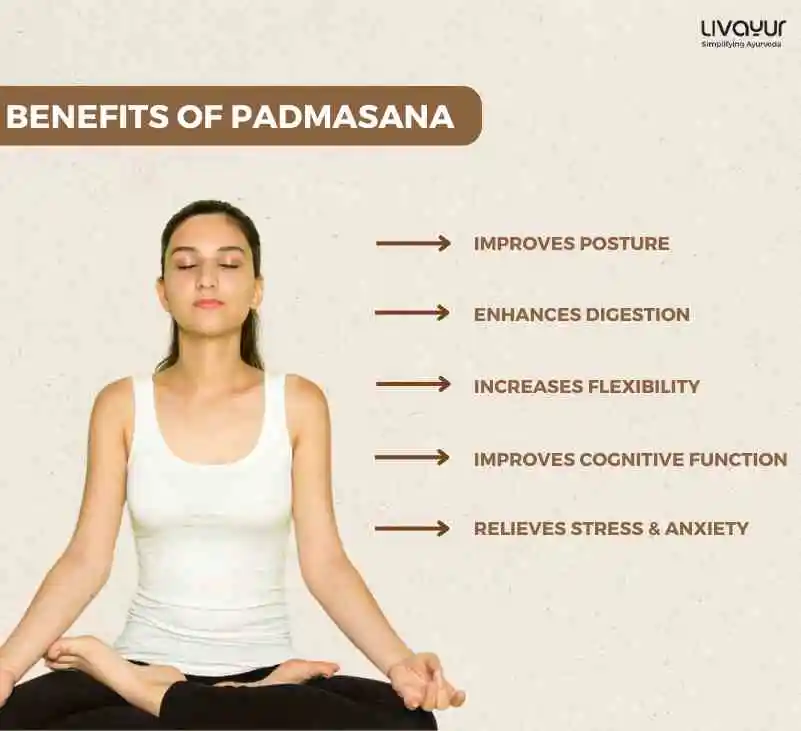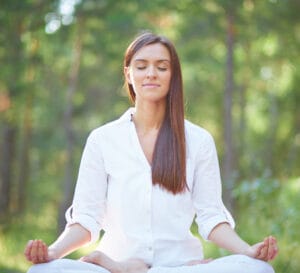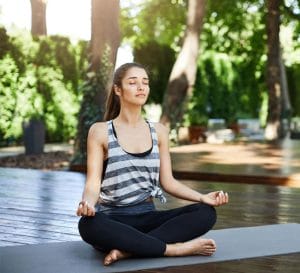
Padmasana, also known as the Lotus Pose, is a seated yoga posture that is commonly used for meditation and pranayama (breathing exercises). In Sanskrit, “Padma” means lotus, and “asana” means pose or posture. The pose is named after the lotus flower because the legs in the pose resemble the petals of a lotus. In yoga philosophy, the Padmasana pose is associated with activating and balancing the energy centers or chakras in the body, particularly the Muladhara (root) and Svadhisthana (sacral) chakras. This is believed to promote a sense of grounding, stability, and emotional balance.
Health Benefits Of Padmasana
The Padmasana offers several potential health benefits, both physical and mental. Here are some of the benefits associated with practicing this pose:
- Improved Posture
Sitting in the Padmasana encourages an upright and aligned posture, which helps strengthen the muscles of the back and core. It promotes a straight spine, which can reduce the risk of developing back and neck pain caused by poor posture[1]. This is perhaps the most best-known of all Padmasana benefits.
- Increased Flexibility
The Padmasana stretches and opens up the hips, knees, and ankles [1]. Regular practice can improve the flexibility of these joints, leading to greater ease of movement and reducing the risk of injuries.
- Enhanced Digestion
Padmasana is believed to stimulate the digestive organs, including the stomach, intestines, and liver. This can help improve digestion, alleviate constipation, and promote overall gastrointestinal health.
- Calmness And Relaxation
Padmasana is often used for meditation and mindfulness practices. Sitting in this pose with a tall spine and closed eyes can help calm the mind, lower blood pressure, reduce stress and anxiety, and promote a sense of inner peace and tranquility [2].
- Increased Focus And Concentration
The meditative aspect of the Padmasana helps to cultivate mental clarity, focus, and concentration. Regular practice can improve cognitive function and enhance productivity in daily activities [3].
- Regulation Of Breath
Padmasana facilitates deep, diaphragmatic breathing, allowing for greater oxygen intake and improved respiratory function. It can also support the practice of pranayama (breathing exercises) by providing a stable and comfortable posture for breath control techniques.
How To Do Padmasana
Just follow these simple Padmasana steps to get started:
- Begin by sitting on the floor or on a yoga mat with your legs extended in front of you.
- Bend your right knee and place the right foot on top of the left thigh. The sole of your right foot should face upward, and the heel should be close to your abdomen.
- Next, bend your left knee and place the left foot on top of the right thigh. The sole of your left foot should also face upward, and the heel should be close to your abdomen.
- Ideally, both knees should touch the floor, and you should feel a sense of balance and stability in the pose.
- Rest your hands on your knees, with palms facing upward. You can also place your hands in a mudra (a symbolic hand gesture) such as Chin Mudra (thumb and index finger touching) or Dhyana Mudra (placing your hands on your lap with one hand on top of the other, palms facing upward).
- Lengthen your spine, relax your shoulders, and keep your head and neck aligned with your spine. Close your eyes and breathe deeply, focusing on your breath and allowing your body and mind to relax.
Precautions
It’s important to note that Padmasana requires a certain level of flexibility in the hips, knees, and ankles. If you find it challenging to sit in the full Padmasana, you can modify it by practicing Ardha Padmasana (Half Lotus Pose) or using props like cushions or blankets to support your knees and hips.
Conclusion
As with any yoga pose, it’s important to practice within your comfort zone and listen to your body. If you experience any pain or discomfort while attempting the Padmasana, it’s best to modify the pose or seek guidance from a qualified yoga teacher.
FAQs
What are the variations of Padmasana pose?
Yoga poses are not only easy to modify but also include numerous variations. Some variations of Padmasana include the Sukhasana, Ardha Padmasana and Baddha Padmasana, among others.
Can I do it when I have back pain?
Padmasana can strengthen your spine, but it should not be practiced if you already suffer from back pain, especially sciatica. Talk to a yoga therapist about suitable asanas to get started.
Is Padmasana to be avoided by anyone?
People suffering from chronic lower back pain or sciatica pain and those with knee injuries should avoid Padmasana.
For how long can I hold Padmasana?
How long you hold the pose depends on you, especially if you are using it for meditation. Ideally, students are advised to stay in the pose for at least a minute or up to 5 minutes at a time.






















